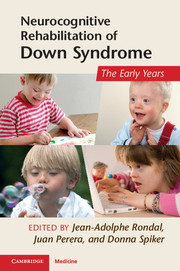Book contents
- Frontmatter
- Contents
- List of contributors
- Preface
- Acknowledgments
- Section 1 Definition, history, methodology, and assessment
- Section 2 Genetics, brain, and animal models
- Section 3 Pharmacological and medical management and treatment
- Section 4 Early development and intervention
- Section 5 Therapeutic perspectives
- 17 Perspectives of hybrid therapeutic strategies in intellectual disabilities and Down syndrome
- Conclusions
- Index
- References
17 - Perspectives of hybrid therapeutic strategies in intellectual disabilities and Down syndrome
Published online by Cambridge University Press: 05 July 2011
- Frontmatter
- Contents
- List of contributors
- Preface
- Acknowledgments
- Section 1 Definition, history, methodology, and assessment
- Section 2 Genetics, brain, and animal models
- Section 3 Pharmacological and medical management and treatment
- Section 4 Early development and intervention
- Section 5 Therapeutic perspectives
- 17 Perspectives of hybrid therapeutic strategies in intellectual disabilities and Down syndrome
- Conclusions
- Index
- References
Summary
Major progress in molecular genetics over the last decades has made it possible to chart a number of mammalian genotypes including the human one composed of approximately 23,000 genes distributed over 23 pairs of chromosomes. Although the particular locations of these genes are known, their exact roles in cell functioning have not been specified yet except for a few hundred. However, the available knowledge is sufficient to support the definition of animal analogs to some conditions leading to intellectual disabilities in humans, such as fragile-X (etiologically linked to a mutation of the gene FMR-1 or FMR-2 on chromosome X) and Down syndrome (DS) (trisomy 21). For example, trisomy 21 in humans is mimicked (genotypically and phenotypically) in mice by experimentally induced trisomy 16. Recent work suggests that it is possible to ameliorate, at least partially, FMR-1 knockout (KO) mice, an animal model of fragile-X syndrome (FXS), at both cellular and behavioral levels in inhibiting the catalytic activity of p21-activated kinase (PAK), a kinase known to play a critical role in actin polymerization and dendritic spine morphogenesis (Hayashi et al., 2007). Greater spine density and elongated spines in the cortex, morphological synaptic abnormalities commonly observed in FXS, are partly restored by postnatal expression of a dominant negative PAK transgene in the forebrain. Likewise, the deficit in cortical long-term potentiation observed in FMR-1 KO mice is fully restored by the PAK transgene.
- Type
- Chapter
- Information
- Neurocognitive Rehabilitation of Down SyndromeEarly Years, pp. 224 - 229Publisher: Cambridge University PressPrint publication year: 2011



